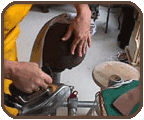 |
 |
 |
|
|||
|
The Village of Hats
Prepared? Ha! The only thing I know about the Andes is the melody to that song...
Judie, singing off-key: "I'd rather be a sparrow than a snail..." 
So, when I get to Quito, I hire a guide named Cecilia and tell her I want to go off the beaten track. Two hours later, we drive into a picturesque little village, with corn growing on the hillside. Young girls are carrying their baby siblings in colorful woven slings. We get out of our car on the main street. I look up and see the snow-covered Andes. I look down and see that the street is lined with sombreros. Rows and rows of black felt fedora hats baking in the mid-day sun. They have a dented crown, a crease in the front and a broad brim. I peek into a shop, muster up a few words of Spanish, and address a wiry young man who is tossing a piece of black felt from one hand to another as though it were a pizza:
Judie: "Qual es su nombre?" A village of fedoras in the middle of the Andes? I ask Cecilia where, exactly, she's taken me, and how these hats came to be here.
Cecilia: "We're in Iluman. Hats were made here in the Spanish Colonial period. That's who taught them to do it. First they used to import them from England. Eventually the Indian people began wearing hats. As Cecilia talks about the Spanish colonials who came to Ecuador hundreds of years ago wearing the fedoras, and how the local Indians began to wear them and then to make them, I hear music coming up on Oswaldo's radio. I'm dreaming. It's "I'd rather be a sparrow than a snail!" Oswaldo, bemused at my off-key humming, begins to make a fedora out of felt in front of my eyes. I ask him what he is doing:
Cecilia translates: "They soak them in this glue then they iron it in this steam so the hat will become very flexible to shape." 
Almost everywhere in the world, hats are factory-made these days, but here in Iluman, tradition is king and everything is still done by hand. After the glue and the steam, Oswaldo puts the felt on a wooden frame or mold, which he spins around rapidly on his work table as he pats and slaps the felt into the shape of a fedora.
Cecilia translates: "You get it on the mold and stretch it. Those irons, by the way, are heated on charcoal...they are very hot irons." I wonder aloud if these hats are just for locals:
Cecilia translates: "People come to buy our hats from Spain, for instance. They make 60 or 70 hats a day." If hat aficionados trek here from Europe, these must be pretty pricey sombreros.
Judie: "How much does a hat cost?" I buy a fine four-dollar fedora, bid adios to Oswaldo, and enter another shop, where the sparrow and snail song isn't playing. About two hundred hats are piled on the counters and shelves. Unlike the fedoras, these have a hard, flat crown and a wide brim and they're black with red or black ribbons.
Cecilia: "These hats are called Cordobes. They're originally from Cordova, from Spain, and these are the hats that the Spanish women in Seville, in Cordova, wear for the festivity of El Rosario and the bullfights. So since this tradition was brought here when the Spanish came, we still have bullfights in Quito the first week of December. It's fashionable to wear in the bullfights - the women look pretty, they think they're more Spanish or feel more Spanish." 
I pass on the fancy bullfight Cordobes. I mean, it would go very well with my basic black traveling dress. But it wouldn't go well with my aversion to blood sports, so I stick with my humble fedora. As I walk down the main street, I'm glad that I wasn't prepared for this trip. Sometimes, when you get off the beaten track, you discover delightful and unexpected surprises. In Iluman, the city of hats, this is Judie Fein, aka Senora Sombrero, for the Savvy Traveler.
|
 | American Public Media Home | Search | How to Listen ©2004 American Public Media | Terms of Use | Privacy Policy |
